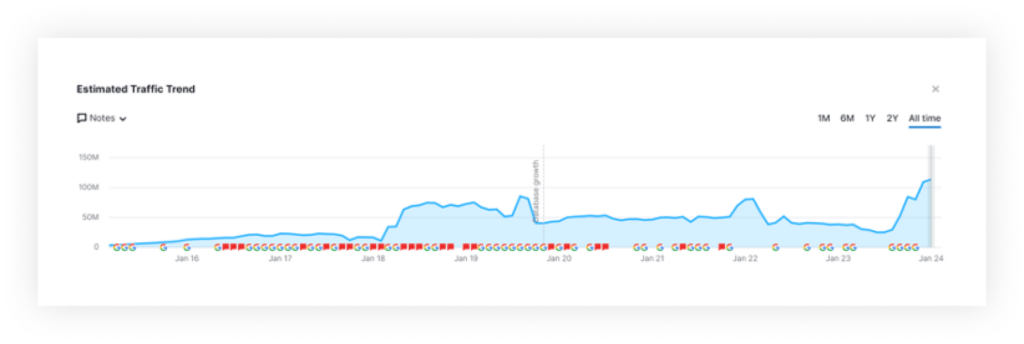SEO in the AI Era

Google’s latest updates changed the way brands drive organic traffic, and where your pages might appear in Google Search rankings. To help you navigate the evolving SEO landscape, Agital tracks, tests, and analyzes all changes implemented by Google, and what each one means for your SEO strategy and recommendations.
Google made several updates to its SEO algorithm, resulting in:
Get more detail below on the specific updates and what they mean.
Helpful Content Update
The helpful content system aims to reward the content that visitors feel provides a satisfying experience. The system runs continuously and considers both content and user experience. As a result, a high ratio of unhelpful content can now affect your sitewide performance.
Core Update
Google’s core updates include significant, broad changes to their search algorithms and systems. Google suggests that sites focus on offering the best content possible and keeping it up to date to stay ahead. If your site is negatively impacted by core updates, you may not see recovery until a new core update is released.
Review Update
Google’s review system is designed to evaluate articles, blog posts, pages, and similar first-party standalone content written with the purpose of providing a recommendation, giving an opinion, or providing analysis. The review system runs continuously.
Spam Update
Spam updates indicate improvements to Spam Brain, Google’s AI-based spam prevention system. If your site is affected, you should review Google’s spam policies—including those around cloaking, doorway pages, link spam, keyword stuffing, and user-generated spam.
Google has always been obsessed with page experience—it’s how they have commanded and maintained the lion’s share of the search engine market.

In June 2021, Google rolled out the Page Experience Update, which introduced Core Web Vitals to the algorithm. Core Web Vitals test the speed, responsiveness, and stability of the page loading experience for users. In April 2023, they connected Helpful Content to Page Experience.
Then, with September 2023’s Helpful Content Update, we noticed that sites with high SEO, Accessibility, and Best Practice Scores in Lighthouse were more likely to perform well than sites with lower scores in those areas. See below for two examples.
Example 1: Performance Change for “Branded Tote Bags”

Example 2: Performance Change for “Blue Light Glasses”

Google provides a checklist of items to review (beyond your Core Web Vitals score) to assess your page experience and find areas of opportunity for improvement.

Calling special attention to the fifth bullet down, “intrusive interstitials” and dialogs are page elements (typically promotional) that obstruct users’ view of the content. Unfortunately, about 25% of sites are still using intrusive interstitials on their first page load to collect email addresses, hurting their SEO performance.
Along with the Helpful Content Update came greater visibility for content in forums such as Reddit and Quora. Here’s what Google had to say about the change:

We can confirm the prioritization of old-school ranking forums by using third-party tools like SEMrush to look at forum visibility.
Reddit – Top 10 Ranking Keywords Over the Last 2 Years (SEMrush)

Reddit – Estimated Organic Traffic Trend (Mobile) Since Jan 2013 (SEMrush)

Quora – Top 10 Ranking Keywords Over the Last 2 Years (SEMrush)

Quora – Estimated Organic Traffic Trend (Mobile) Since Jan 2013 (SEMrush)

Check Your Brand Mentions
Check your mentions using the “brand name” search in Google (site:domain.com). Then, check your competitor mentions using the same method—and make sure you’re mentioned in the same conversations!
Know When Forums Are Coming for Your Terms
Add reddit.com, quora.com, etc. as competitors in your rank tracking software to see when they’re appearing for your top terms. This is a great way to find the forum threads relevant to your site.

Enable Upvotes for User Generated Content
In places where you have user generated content (UGC)—such as product reviews, product Q&A, etc.—enable features where users can upvote helpful information.
Double-Check Your Schemas
Make sure you’re using appropriate schema and fully utilizing all markup types.
Mobile Usability
Mobile Site Structure
Mobile-Friendly Content

When used appropriately, AI content is not against Google’s guidelines. Google does not penalize AI-generated text, and aims to reward high-quality content, even if it’s produced by AI.
Test 1: Auto-Generate Meta Descriptions
Business: A B2B landscape supply chain with hundreds of locations across the US and Canada.
Challenge: Their product pages did not have meta descriptions.
Hypothesis: Mass-populating meta descriptions in bulk with ChatGPT would entice more users to click through vs. using the default text pulled in from the page.
Results: Product pages with auto-generated meta descriptions had a +18.9% higher click-through rate than product pages that did not get the description added.
Test 2: Bulk Populate Product Descriptions
Business: A B2C ecommerce apparel company.
Challenge: They had hundreds of product variants with unique URLs—all with duplicate content.
Hypothesis: It’s better to have unique, AI-generated content on product pages than thin or duplicate human-written content.
We tested two product categories: one with longer-form content, the other with <150 words.
Results: Pages without unique content grew 37%, AI content grew an average of 189%.

If you’re not exactly sure where to start in your journey to the top of Google’s search rankings, you are not alone. Many ecommerce and lead gen brands have come to us with questions about how to get started and what benchmarking tools are the best.
That’s why we created our favorite tool for helping business leaders assess their current SEO performance and identify new opportunities—the SEO Scorecard—also a favorite tool of the many clients we have helped slay their SEO goals! It’s easy, free, and truly eye-opening.
